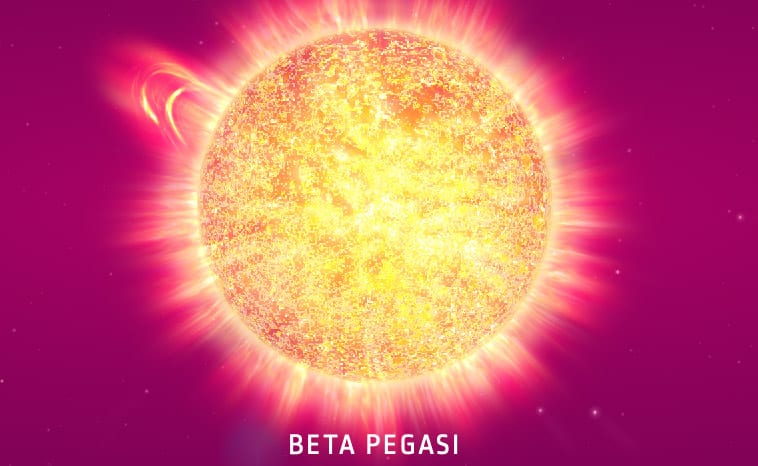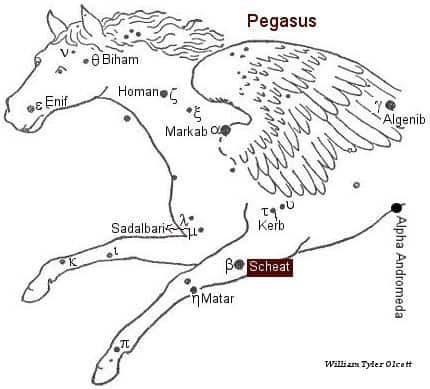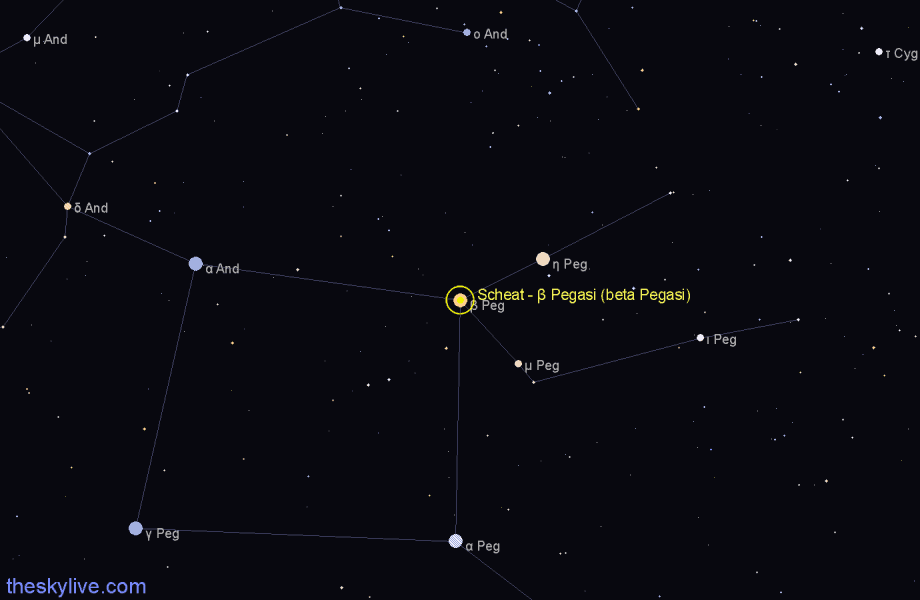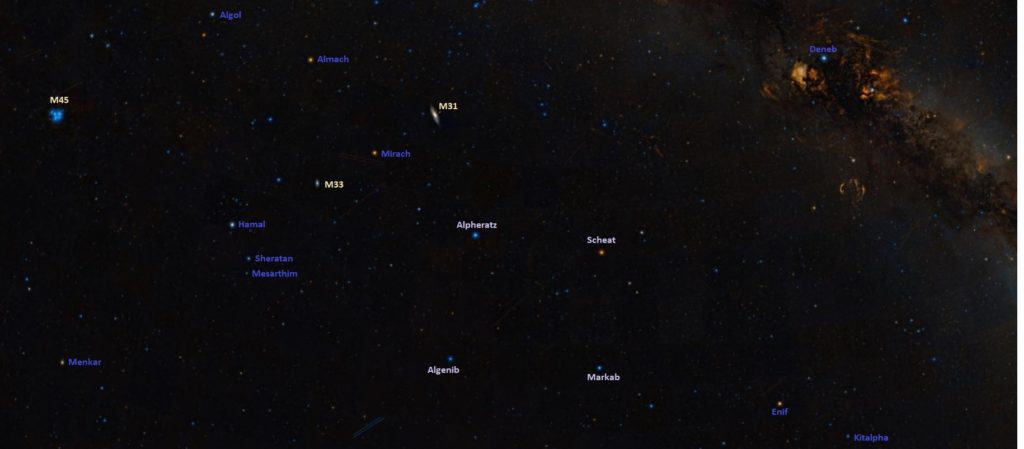Scheat, designated as Beta Pegasi, is a red giant star located in the constellation of Pegasus. It is the second-brightest star in its constellation after Epsilon Pegasi.
Key Facts & Summary
- Scheat is located at around 196 light-years / 60.1 parsecs away from the Sun.
- It is part of a prominent rectangular asterism known as the Great Square of Pegasus, forming its upper right corner.
- Scheat is a red giant star of spectral type M2.5II-IIIe, indicating that its spectrum has characteristics part way between a bright giant and a giant star.
- Due to its stellar evolution, Scheat has expanded several times its radius, having around 95 solar radii, and around 2.1 solar masses.
- Thus, this star is almost 200 times bigger than our Sun.
- Scheat has a surface gravity of 1.20 cgs.
- The star has an apparent magnitude of 2.42 and an absolute magnitude of -1.41.
- Scheat is classified as a semi-regular variable type of star, having brightness variations between 2.31 to 2.74 magnitudes within a period of 43.3 days.
- Scheat is around 1,500 times brighter than our Sun.
- This star is unusual among bright stars since it has a relatively cool surface temperature, at least in comparison to our Sun. The average surface temperature on Scheat has been estimated at around 3,689 K.
- Scheat has a radial velocity of +8.7 km / +5.4 mi per second.
- The rotational velocity of Scheat has been estimated at around 9.7 km / 6 mi per second.
- Scheat is losing mass at a rate of around 10-8 times the Sun’s mass per year.
- This mass loss is the reason for the presence of an expanding shell of gas and dust that surrounds Scheat.
- The shell is gigantic, having a radius of around 3,500 times the Sun’s radius or around 16 AU.
The star’s name, Scheat, comes from an Arabic phrase that translates to “the upper arm” – referring to the star’s position in the asterism. The same name was also used for Delta Aquarii, now known as Skat.

In the 17th century, astronomers Johann Bayer and Giovanni Riccioli called the star Seat Alpheras and Scheat Alpheraz respectively. The names mean “the upper arm of the horse”.
Formation
The star Scheat / Beta Pegasi formed out of an interstellar medium of dust and gas several millions of years ago. Gravity pulled the swirling gas and dust together and when it reached the right temperature, the second-brightest star of the Pegasus constellation, Scheat, emerged. The star’s exact age is currently unknown.
Distance, Size, and Mass
Scheat is located at around 196 light-years / 60.1 parsecs away from the Sun. It is much more massive than our Sun, having 2.1 solar masses, or 210% of the Sun’s mass.

In regards to its size, Scheat has radius of 95 solar radii or 9500% of our Sun’s radius. This means that it’s diameter is more than 180 times greater than our Sun’s.
Other Characteristics
Scheat / Beta Pegasi, has a stellar classification of M2.5II-IIIe, indicating a giant (III) or bright giant (II) star, appearing reddish-orange in color.
Scheat is roughly 1500 times brighter than our Sun, though most of its light is in the infrared part of the spectrum. Its brightness is unusual in comparison to its temperature. Scheat is much cooler than our Sun, having surface temperatures of around 3,689 K, or only 60% of our Sun’s heat.

Scheat’s photosphere is sufficiently cool for molecules of titanium oxide to form. Since Scheat is losing mass at a rate of around 10-8 solar masses per year due to a strong stellar wind, the star is enveloped by an expanding envelope of dust and gas which has around 3,500 times our Sun’s radius, or 16 AU.
Scheat is classified as a semi-regular variable type of star, having brightness variations between 2.31 to 2.74 magnitudes within a period of 43.3 days. The rotational velocity of Scheat has been estimated at around 9.7 km / 6 mi per second.
Location
Scheat / Beta Pegasi is located in the constellation of Pegasus, the celestial winged horse. It is the second-brightest star in the constellation after Enif / Epsilon Pegasi.
The constellation of Pegasus is the seventh-largest constellation in the sky, occupying an area of 1,121 square degrees. It is one of the Greek constellations, first listed by the ancient astronomer Ptolemy, in the 2nd century CE.

Scheat marks the northwest vertex of the Great Square of Pegasus. Out of the four stars of the square, Scheat is the closest to the Northern Cross asterism located in the constellation of Cygnus. The galaxy NGC 7487 lies in the same field of view as Scheat.

To find the Great Square of Pegasus, one must use the bright stars of the Cassiopeia constellation that form a distinct W-shape pattern. A line drawn from Segin, though Ruchbach, points in the direction of the asterism.
The constellation of Pegasus hosts several notable deep sky objects such as the bright globular cluster Messier 15, the compact galaxy group Hickson 92, and it’s brighter neighbor the spiral galaxy NGC 7331, the gravitationally lensed quasar known as Einstein’s Cross, and the spiral galaxies NGC 7814, NGC 7742, and NGC 7479, among other celestial objects.
The best time of the year to observe the stars and the other deep-sky objects of the Pegasus constellation is during the month of October when the constellation rises high in the evening sky.

The Future
Scheat has undoubtedly expanded its radius due to its current stellar evolution, and it will continue to do so for a long time. The star isn’t massive enough to explode as a supernova, and as such it will probably become a dead star in the near future, as its losing mass quite quickly.
Did you know?
- Scheat is the biggest star of the Great Square of Pegasus asterism, as the other three, Markab, Algenib, and Alpheratz, are under 5 solar radii.
- In Arabic astronomy, Scheat was known as Mankib al Faras – the horse’s shoulder – or as Menkib. The name Menkib was mentioned by the 15th-century Timurid astronomer Ulugh Beg.
- The Chinese know Scheat as the Second Star of Encampment – The Encampment is a Chinese asterism, and it is part of the seven mansions of the Black Tortoise, formed by the stars Markab and Scheat, the western stars of the Great Square of Pegasus.
- The stars, Scheat and Markab, can be used to find Fomalhaut, the 18th brightest star in the night sky. A line extended from Scheat through Markab points directly to Fomalhaut.
Sources:
Image Sources:
- https://www.star-facts.com/wp-content/uploads/2020/04/Scheat-1229×620.jpg?189db0&189db0
- https://osr.org/wp-content/uploads/2019/11/beta-pegasi-star.jpg
- https://www.star-facts.com/wp-content/uploads/2020/04/Scheat.jpg?189db0&189db0
- https://www.constellationsofwords.com/images/stars/Scheat.JPG
- https://theskylive.com/sky/stars/finder-charts/scheat-beta-pegasi-finder-chart.png?c=1586734619
- https://www.star-facts.com/wp-content/uploads/2020/04/Great-Square-of-Pegasus-location.jpg?189db0&189db0
